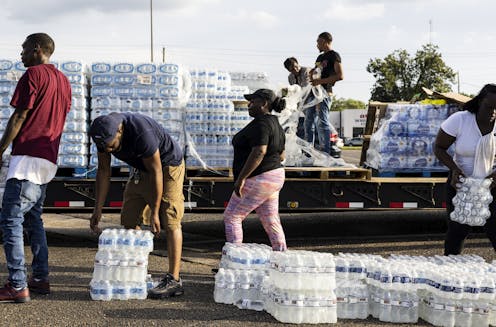Intense heat waves and flooding are battering electricity and water systems, as America's aging infrastructure sags under the pressure of climate change
- Written by Paul Chinowsky, Professor of Civil Engineering, University of Colorado Boulder

The 1960s and 1970s were a golden age of infrastructure development[1] in the U.S., with the expansion of the interstate system and widespread construction of new water treatment, wastewater and flood control systems reflecting national priorities in public health and national defense. But infrastructure requires maintenance, and, eventually, it has to be replaced.
That hasn’t been happening in many parts of the country. Increasingly, extreme heat and storms are putting roads, bridges, water systems and other infrastructure under stress.
Two recent examples – an intense heat wave that pushed California’s power grid to its limits[2] in September 2022, and the failure of the water system[3] in Jackson, Mississippi, amid flooding in August – show how a growing maintenance backlog and increasing climate change are turning the 2020s and 2030s into a golden age of infrastructure failure.
I am a civil engineer[4] whose work focuses on the impacts of climate change on infrastructure. Often, low-income communities and communities of color like Jackson see the least investment in infrastructure replacements and repairs.
Crumbling bridge and water systems
The United States is consistently falling short on funding infrastructure maintenance. A report by former Federal Reserve Board Chairman Paul Volcker’s Volker Alliance in 2019 estimated the U.S. has a US$1 trillion backlog of needed repairs[5].
Over 220,000 bridges across the country – about 33% of the total – require rehabilitation or replacement[6].
A water main break now occurs somewhere in the U.S. every two minutes[7], and an estimated 6 million gallons of treated water are lost each day. This is happening at the same time the western United States is implementing water restrictions amid the driest 20-year span in 1,200 years. Similarly, drinking water distribution in the United States relies on over 2 million miles of pipes that have limited life spans.
The underlying issue for infrastructure failure is age, resulting in the failure of critical parts such as pumps and motors.
Aging systems have been blamed for failures of the water system in Jackson, wastewater treatment plants in Baltimore[8] that leaked dangerous amounts of sewage into the Chesapeake Bay and dam failures in Michigan[9] that have resulted in widespread damage and evacuations.
Inequality in investment
Compounding the problem of age is the lack of funds to modernize critical systems and perform essential maintenance. Fixing that will require systemic change.
Infrastructure is primarily a city and county responsibility financed through local taxes. However, these entities are also dependent on state and federal funds[10]. As populations increase and development expands, local governments have cumulatively had to double their infrastructure spending[11] since the 1950s, while federal sources remained mostly flat.
Power outages[22] during California’s September 2022 extreme heat wave are another potentially life-threatening infrastructure problem.
The rising costs of delayed repairs
My research with colleagues shows that the vulnerability of the national transportation system, energy distribution system, water treatment facilities and coastal infrastructure will significantly increase over the next decade[23] due to climate change.
We estimate that rail infrastructure faces additional repair costs of $5 billion to $10 billion annually by 2050, while road repairs due to temperature increases could reach a cumulative $200 billion to $300 billion by the end of the century. Similarly, water utilities are facing the possibility of a trillion-dollar price tag by 2050[24].
After studying the issue of climate change impacts on infrastructure for two decades, with climate projections getting worse, not better, I believe addressing the multiple challenges to the nation’s infrastructure requires systemic change.
Two items are at the top of the list: national prioritization and funding.
Prioritizing the infrastructure challenge is essential to bring government responsibilities into the national conversation. Most local jurisdictions simply can’t afford to absorb the cost of needed infrastructure. The recent infrastructure bill and the Inflation Reduction Act[26] are starting points, but they still fall short of fixing the long-term issue.
Without systemic change, Jackson, Mississippi, will be just the start of an escalating trend.
References
- ^ golden age of infrastructure development (onlinelibrary.wiley.com)
- ^ power grid to its limits (www.kcra.com)
- ^ failure of the water system (www.nytimes.com)
- ^ civil engineer (www.colorado.edu)
- ^ US$1 trillion backlog of needed repairs (www.volckeralliance.org)
- ^ require rehabilitation or replacement (artbabridgereport.org)
- ^ every two minutes (infrastructurereportcard.org)
- ^ wastewater treatment plants in Baltimore (www.scribd.com)
- ^ dam failures in Michigan (www.cnbc.com)
- ^ dependent on state and federal funds (www.nlc.org)
- ^ double their infrastructure spending (www.cbo.gov)
- ^ Congressional Budget Office (www.cbo.gov)
- ^ 2 million people (uswateralliance.org)
- ^ greatest predictor of those who lack this access (static1.squarespace.com)
- ^ found disproportionate impacts (www.montgomeryadvertiser.com)
- ^ requested infrastructure funding (htv-prod-media.s3.amazonaws.com)
- ^ tore apart a bridge (dot.ca.gov)
- ^ Phoenix airport to cancel flights (phys.org)
- ^ buckled roads and melted streetcar cables (abcnews.go.com)
- ^ Amtrak slowed its train (abcnews.go.com)
- ^ Jacob W. Frank/National Park Service (www.flickr.com)
- ^ Power outages (www.latimes.com)
- ^ will significantly increase over the next decade (doi.org)
- ^ a trillion-dollar price tag by 2050 (www2.nacwa.org)
- ^ Jeff Swensen/Getty Images (www.gettyimages.com)
- ^ infrastructure bill and the Inflation Reduction Act (theconversation.com)
Authors: Paul Chinowsky, Professor of Civil Engineering, University of Colorado Boulder

